Russian crude exports fell 10% to a six-month low in May, according to tanker tracking data, after flows to India, its biggest customer, contracted from a recent surge to record highs and refining runs partly recovered from Ukrainian attacks.
Crude shipments from Russian ports averaged 3.52 million b/d in May, down 390,000 b/d from 3.91 million b/d in April led by a fall in cargoes of Urals crude from its Baltic and Black Sea ports Primorsk and Novorossiisk, according to S&P Global Commodities at Sea.
Russia’s May crude exports, which are in line with average levels of 3.5 million b/d over the last year, come as Russian refiners repaired some damaged capacity despite ongoing attacks from Ukrainian drones. Under pledges to OPEC+, Russia promised to transition its voluntary crude supply cut to a crude production cut in the third quarter. This includes May exports of 71,000 b/d below its May-June 2023 average, down from 121,000 b/d in April.
The biggest fall in crude exports came from India, the data shows, with a contraction of almost 700,000 b/d on the month to a three-month low of 1.61 million b/d in May. In April, Russian crude exports to India surged to record 2.1 million b/d, the highest since India became Russia’s biggest oil buyer in the wake of the war in Ukraine. The jump came after an apparent resolution of a currency payment dispute with Moscow and Russia’s moves to sidestep sanctions on its oil exports which previously saw Indian refiners shunning Russia’s Sovcomflot tanker fleet.
As the world’s third-biggest consumer of crude with a high import dependency, Indian refineries are also sensitive to oil prices.
Compared with Dated Brent, the discount for Urals crude delivered to India shrank to a low of $3.25/b in the third week of May, according to assessments by Platts, part of S&P Global Commodity Insights. Platts first assessed Ural delivered to the West Coast of India at a minus $19/b discount to Brent in January 2023.
Crude exports to China, Russia’s number two crude buyer, fell by around 100,000 b/d on the month to 1.13 million b/d as Chinese refiners continue to undergo seasonal maintenance, propelling total downtime in Asia to 2.72 million b/d during the week ending May 24, according to Commodity Insights.
Product flows
Russian oil product exports in May rose slightly, however, helped by a rebound in gasoline shipments after Moscow suspended a temporary ban on exports.
Seaborne Russian export loadings of diesel, fuel oil, naphtha and other refined products averaged 2.13 million b/d, the data shows, up 3% on the month but still some 500,000 b/d below January levels when Ukraine began a barrage of long-range drone strikes on Russian refining capacity.
Currently, four refineries in Russia are partially or completely inoperable due to drone attacks, totaling a loss of around 455,000 b/d in crude unit capacity, according to Commodity Insights estimates. In March, there were up to seven Russian refineries partly offline due to damage from Ukrainian drone attacks affecting more than 1 million b/d in lost capacity.
Russia’s biggest fuel exports diesel and gasoil averaged 810,000 b/d in May, up slightly from 805,000 b/d in April but still close to six-month lows, the data showed.
Russia’s April oil product export slump was led by fuel oil, however, which shrank 147,000 b/d on the month and 220,000 b/d since January. Exports of fuel oil, naphtha, and gasoline, however, rose by 130,000 b/d combined on April levels, the data shows.
Source: Hellenic Shipping News





